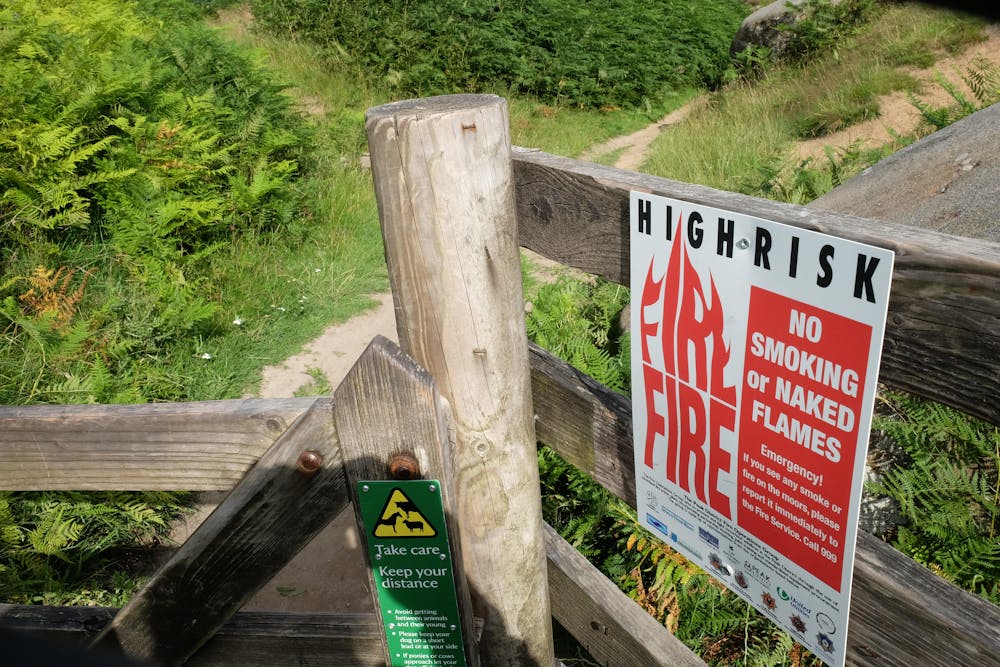The Impact Of Wildfires On The UK's Most Endangered Animals

Table of Contents
Habitat Loss and Fragmentation Due to Wildfires
Wildfires cause catastrophic habitat loss and fragmentation, significantly impacting the survival of many endangered species. The intense heat destroys crucial vegetation, leaving behind barren landscapes unsuitable for many animals.
Impact on Specific Species
The destruction of habitat directly threatens the survival of many UK endangered animals.
- Nightjar (Caprimulgus europaeus): These birds rely on heathland for nesting and foraging. Wildfires destroy their nesting sites and eliminate vital insect prey.
- Sand Lizard (Lacerta agilis): This reptile depends on specific types of open, sunny habitats. Wildfires can obliterate their basking sites and shelter.
- Hazel Dormouse (Muscardinus avellanarius): These arboreal mammals depend on diverse woodland habitats for food and nesting. Wildfires destroy their food sources (nuts and berries) and nesting sites.
- Adder (Vipera berus): Adders require specific microhabitats for thermoregulation and shelter. Wildfires can severely limit suitable habitat.
The fragmentation of remaining habitats isolates populations, reducing genetic diversity and making them more susceptible to disease and inbreeding depression, increasing the risk of local extinction.
Long-Term Ecosystem Changes
The recovery of habitats damaged by wildfires is a slow and complex process.
- Changes in plant communities can result in a loss of biodiversity and a shift towards less desirable vegetation.
- Soil erosion increases, further degrading habitat quality and reducing nutrient availability.
- Water quality can be negatively impacted by ash runoff and increased sediment loads.
Invasive species often colonize burned areas, outcompeting native plants and further threatening endangered species that rely on specific plant communities for survival. The long-term consequences of wildfires can have devastating effects on the delicate balance of UK ecosystems.
Direct Mortality and Injury from Wildfires
Wildfires cause direct mortality and injury to animals through a variety of mechanisms.
Immediate Impacts
The intense heat and flames of a wildfire directly kill animals.
- Slow-moving reptiles, such as adders and sand lizards, are particularly vulnerable as they are unable to escape quickly.
- Animals with limited mobility, such as young or injured animals, are at increased risk.
- Smoke inhalation can lead to respiratory failure and death.
- Thermal stress can cause organ damage and death.
The immediate aftermath of a wildfire often necessitates challenging rescue and rehabilitation efforts for injured animals.
Long-Term Health Effects
Even animals that survive a wildfire can suffer long-term health consequences.
- Smoke inhalation can lead to chronic respiratory problems.
- Exposure to toxins released during a fire can weaken immune systems, making animals more susceptible to disease.
- Reproductive issues can arise from exposure to toxins, reducing population growth.
These long-term health effects can contribute to population decline, further endangering already vulnerable species.
Climate Change and the Increased Risk of Wildfires
Climate change is significantly increasing the frequency and intensity of wildfires in the UK.
The Link Between Climate Change and Wildfires
Rising temperatures, prolonged droughts, and increased flammable vegetation create ideal conditions for wildfires to ignite and spread rapidly.
- Higher temperatures dry out vegetation, increasing its flammability.
- Prolonged droughts reduce soil moisture, making it easier for fires to start and spread.
- Changes in vegetation patterns, with an increase in drier, more flammable species, contribute to the risk.
The scientific community overwhelmingly agrees on the connection between climate change and the increasing threat of wildfires.
Future Predictions and Conservation Strategies
Predictions indicate that wildfire risk will continue to increase in the UK in the coming decades. Proactive conservation strategies are crucial to mitigate the impact on endangered species.
- Habitat restoration projects can create firebreaks and enhance resilience to wildfire.
- Prescribed burns, carefully controlled burns under specific conditions, can reduce the fuel load and prevent larger, more devastating wildfires.
- Improved wildfire management techniques, including early detection and rapid response, are crucial.
- Public awareness and engagement are vital to prevent accidental wildfires.
Collaboration between government agencies, conservation organizations, and the public is essential to protect UK endangered animals from the escalating threat of wildfires.
Conclusion
Wildfires pose a severe and multifaceted threat to the UK's endangered animals. The loss of habitat, direct mortality, and long-term health consequences, all exacerbated by climate change, create an urgent need for effective conservation measures. Protecting the UK's endangered animals from the increasing threat of wildfires requires immediate action. We must support organizations dedicated to wildlife conservation, participate in wildfire prevention initiatives, and advocate for policies that address climate change. Learning more about the issue and taking action to protect these precious species is crucial for the future of UK biodiversity. Let's work together to safeguard the UK's endangered animals from the devastating impacts of wildfires.

Featured Posts
-
 Hl Antha Qanwn Dy Kabryw Llmwaedt Allqae Alakhyr Ykshf Alhqyqt
May 13, 2025
Hl Antha Qanwn Dy Kabryw Llmwaedt Allqae Alakhyr Ykshf Alhqyqt
May 13, 2025 -
 Cassie Ventura Reveals Third Pregnancy
May 13, 2025
Cassie Ventura Reveals Third Pregnancy
May 13, 2025 -
 Upcoming Overhaul Of Sec Crypto Broker Regulations What To Expect
May 13, 2025
Upcoming Overhaul Of Sec Crypto Broker Regulations What To Expect
May 13, 2025 -
 U S Customs Duty Collections April 2024 Sets Record At 16 3 Billion
May 13, 2025
U S Customs Duty Collections April 2024 Sets Record At 16 3 Billion
May 13, 2025 -
 Maluf Fords Brazilian Legacy Fades As Byds Global Ev Dominance Grows
May 13, 2025
Maluf Fords Brazilian Legacy Fades As Byds Global Ev Dominance Grows
May 13, 2025
